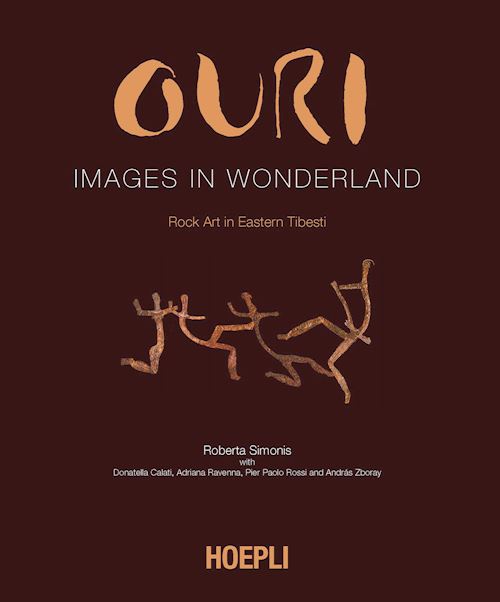Suggerimenti
Qui di seguito alcuni testi suggeriti

Ouri, Images in Wonderland marks a remarkable advance in publications of prehistoric rock art in the Ouri plain (Eastern Tibesti, Chad). In the early 1990s, the Tibesti was again accessible after a 20-years-long period of unrest. At that time, the European experts of African rock art were scarcely aware of the exceptionality of the Ouri art, only known through the publication of a restricted number of papers.
The author Roberta Simonis and her collaborators offer a compendium of the research carried out by Aldo Boccazzi, Donatella Calati, Adriana Ravenna and Sergio Scarpa Falce in the years 1993-2009, when they organised eight reconnaissance expeditions to the Ouri plain, either together or in the company of other rock art enthusiasts. Not only they revisited the decorated sites published by the early explorers, but reported a large number of new findings. Their observations and photographic documents form the groundwork of this book and the quality of András Zboray’s digital photographs helps improve the comprehension of the unique art of this remote part of the Sahara.The book includes two maps and over 1600 figures, with colour photographs, DStretch treatments, tracings of single figures and several overall pictures showing the complexity of the larger painted panels. The volume is divided into 23 chapters of unequal length, each dealing with a different area of the Ouri plain.
The magic valley - The “Korossom Fantastic” style - Handprints - The Karnasahi style - Later styles - The sequence - Compass graves: a view from above - 1. Mossei, life on the Red Planet - 2. Ouri, a solitary village - 3. Siekouba, the giant cows - 4. Ouri Sao, herding and hunting - 5. Ehi Tourkoui, the simple people - 6. Araské, the lava flow - 7. Borou, the amazing variety - 8. Borboré, facts and visions - 9. Fofoda, masters of art - 10. Luli Edrienga, the pretty dogs - 11. Karnasahi, cattle on the move - 12. The wizard of Tcherougué - 13. Dahobou, the playful monkeys - 14. Ounga, the elephant hideout - 15. Korossom, the crazy dancers - 16. Tiezy, a quiet day - 17. Toundin, the “fantastic” chaos - 18. Farouanama, the weird ostriches - 19. Tehi Drossou, the awesome beasts - 20. Goneké, the spiral creature - 21. Tuhimmi, a western outpost - 22. Binem, the southern track - 23. Dohone, the northern reaches.
Roberta Simonis first encounter with prehistoric rock art in the Sahara was in the early seventies. The amazing beauty of the naturalist depictions of wildlife in the Mathendush area in Libya was so impressive that she and her husband Giancarlo Negro, in the following decades, dedicated most of their free time to the study of prehistory and travelled thousands of kilometres in the Sahara desert, on and off track, always in search of the artistic achievements of the prehistoric inhabitants. In 1993, after a first visit to the Ennedi region with Adriana Ravenna and Sergio Scarpa Falce and the finding of an unpublished engraved panel depicting a group of the so-called “Niola Doa dancers”, their attention focused on the little known art of northern Chad. In the years 1989 throughout 2013 Roberta Simonis has been the publisher and editor of the yearly review ‘Sahara, Prehistory and History of the Sahara’, which published many papers by prestigious prehistorians and archaeologists and the most important findings of Saharan parietal art.
Qui di seguito alcuni testi suggeriti